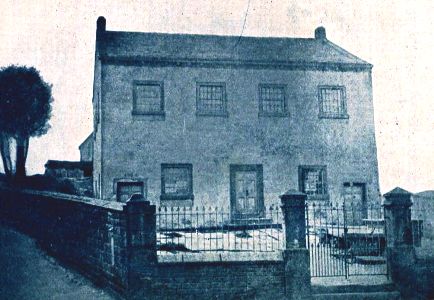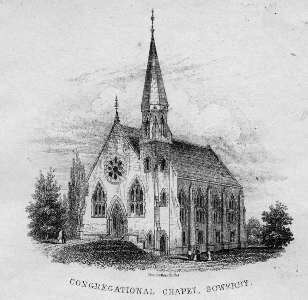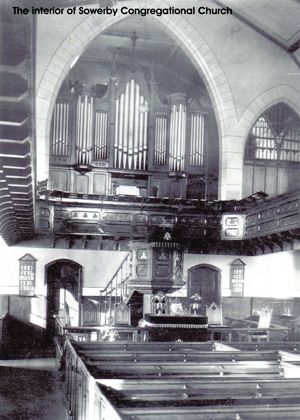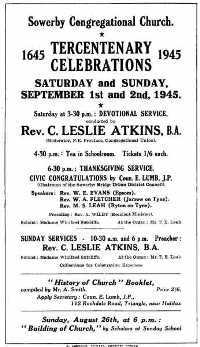









 |
||
Sowerby Congregational Church
Also known as Old Green Congregational Church.  Root's "gathered congregational" Church was formed whilst he was still the incumbent at Sowerby, it didn't represent a building but a spiritual society formed within the existing church. The formation of this society was however extremely distasteful to the Presbyterian's, they not only remonstrated against his view of Church order and discipline, but when his society advanced to the selection of deacons, they got some of the inhabitants to close the Church doors on the Sunday so that proceedings could not take place. On the Sunday in question, the pastor demanded that the people stand by each other in defence of their rights " as Abraham did by Lot, and Moses by the Hebrew captives" which they twisted his meaning into an argument for armed resistance. In 1662 Mr Root was sent to York Castle for 3 months for refusing to subscribe to the "Act of Uniformity" of 1662, but his time in prison didn't crush his principles; he died in 1669 and was buried at Sowerby. The Act of Uniformity was an Act of Parliament of 1662 which prescribed the form of public prayers, sacraments, and other rites of the Established Church of England, following the rites, ceremonies and doctrines as laid out in the Book of Common Prayer. Adherence to this was required to hold any office in government or the church, although the Book of Common Prayer (1662 edition) prescribed by the act was so new that most people had never even seen a copy. It also required ordination for all ministers, which was reintroduced after the Puritans had abolished many features of the Church during the Civil War. In 1673 a license was secured for a Presbyterian meeting house which had been erected by Joshua Horton at Quarry hill, (the position of this house is not known but is unlikely to be the Quaker house due to a conflict of dates) here a weekly service was conducted in turn by Oliver Heywood of Northowram, Eli Bentley, Joseph Dawson and Timothy Root, the son of Henry, until the licence was withdrawn in 1675.  The second minister was Mr Thorburn succeeded by Mr Andrews, it was during the latter ministers incumbency that some of the members of the church became so dissatisfied with the doctrine that he preached that they left and went to worship at Steep lane where a chapel was built in 1751, the Church there was an independent Church until 1779 when it became a Baptist Church. The 9th minister was a Mr Hatton; he lived in one of the old houses near the Chapel. It was during his ministry that various alterations to the building took place, the ground floor was lowered 18 inches as the gallery was too low, and for safety the walls were underfooted, this was in 1812: in 1824 the manse was built and seven years later a schoolroom was built against the back wall of the Chapel, it was not very attractive but produced much good.  At this time the hymn singing had been accompanied by Violin, cello, clarinet and bassoon but there was a growing feeling in favour of an organ, one was located and bought from a Mr. Sykes of Triangle, this was installed but proved rather unsatisfactory, so it was removed to a Mr Pickles house for storage. More accommodation was needed in the school so after carefully considering the matter it was decided that they couldn't justify spending any more on the old building, but must build a new one. After due consideration and with the assistance and encouragement of Mr. John Crossley of Halifax and Mr. Garnet of Bradford the decision to go ahead was taken. Soon afterwards a thousand yards of land was bought on a 999 years lease and a decision to sell the stored Organ was taken but not to take less than £10 for it, also arrangements were made to store the benches, tables, desk and pulpit at various locations.  As with most Church buildings, a stone laying ceremony was arranged and duly performed, under the stone was the usual information laid with all the details of the ceremony, the minister, deacons etc. and a potted history. The new Church and Sunday school were opened in June of 1861 six months later it is recorded that there were a total of 216 teachers and scholars on the books. At a meeting held in June 1862 it was resolved that a bazaar be got up towards paying off the debt, and the project was taken up very heartily, the bazaar was held at Sowerby and also at the Mechanic's hall in Halifax raising the goodly sum of £160. The debt for building the Church was cleared in 1868; in the same year a tea meeting was held to inaugurate the lighting of the chapel with gas. In the summer of 1889 the chapel was renovated throughout, and at the annual finance meeting in 1896 it was decided to erect a new kitchen and two vestries, these additions were delayed until 1899, the Sunday school now had seven vestries plus the kitchen. Meanwhile the dilapidated condition of the farm at Red Brink was cause for concern so it was decided to pull it down and rebuild on the same site, this meant an outlay of over £300. Two memorial stones were incorporated in re build, one had the inscription Endowed 1737 and the other Rebuilt 1902. The church survived until after the Second World War, but the congregation gradually declined and were unable to keep up with the general maintenance and some storm damage, the coping stones on the east end of the church roof gave cause for concern so it was decided by the deacons meeting in 1977 that there was no option but to close the building, so after 332 years of the Chapel at Sowerby the building was closed, and demolition took place in the summer of 1980.    Ministers at the Church have included: Ministers at the Church have included:
For the location please see the main village photograph 
|
||
| |
||